Ministry of the Navy of Japan

The Navy Ministry of Japan (海軍省 Kaigunshō) was a cabinet-level ministry in the Empire of Japan charged with the administrative affairs of the Imperial Japanese Navy (IJN). It existed from 1872 to 1945.
History
The Navy Ministry was created in April 1872, along with the Army Ministry, to replace the Ministry of the Military (兵部省 Hyōbushō) of the early Meiji government.
Initially, the Navy Ministry was in charge of both administration and operational command of the Imperial Japanese Navy. However, with the creation of the Imperial Japanese Navy General Staff in May 1893, it was left with only administrative functions.
"The ministry was responsible for the naval budget, ship construction, weapons procurement, personnel, relations with the Diet and the cabinet and broad matters of naval policy. The General Staff directed the operations of the fleet and the preparation of war plans".[1] The post of Navy Minister was politically powerful. Although a member of the Cabinet after the establishment of the cabinet system of government in 1885, the Navy Minister was answerable directly to the Emperor (the commander-in-chief of all Japanese armed forces under the Meiji Constitution) and not the Prime Minister.
Up until the 1920s, the Navy Ministry held the upper hand over the Navy General Staff in terms of political influence. However, the officers of the Navy General Staff found an opportunity at the Washington Naval Conference in 1921–22 to improve their situation. At this meeting, the United States and Britain wanted to establish a worldwide naval ratio, asking the Japanese to limit themselves to a smaller navy than the Western powers. The Naval Ministry was willing to agree to this, seeking to maintain the Anglo-Japanese Alliance, but the Navy General Staff refused. The Imperial Japanese Navy became divided into mutually hostile Fleet Faction and Treaty Faction political cliques. Ultimately, the treaty was signed by Japan, but terminated in 1934. Through the 1930s, with increasing Japanese militarism, the Fleet Faction gradually gained ascendancy over the Treaty Faction and came to dominate the Navy General Staff, which pushed through the attack on Pearl Harbor against the resistance of the Navy Ministry.
After 1937, both the Navy Minister and the Chief of the Navy General Staff were members of the Imperial General Headquarters.
With the defeat of the Empire of Japan in World War II, the Navy Ministry was abolished together with the Imperial Japanese Navy by the American occupation authorities in November 1945 and was not revived in the post-war Constitution of Japan.
Organization
Internally operating divisions
- Military Affairs Bureau
- Mobilization Bureau
- Technical Bureau
- Personnel Bureau
- Training Bureau
- Medical Bureau
- Shipyard Bureau
- Naval Construction Bureau
- Legal Bureau
- Administrative/Accounting Bureau
Externally operating divisions
- Navy Aviation Bureau
- Navy Academy
- Naval War College (Japan)
- Naval Accounting School
- Navy Medical School
- Naval Engineering School
- Submarine Division
- Canals and Waterways Division
- Naval Technical Department
- Naval Tribunal
- Tokyo Naval Tribunal
- Chemical Warfare Division
- Radio and Radar Division
- Supply and Transport Bureau
- Naval Construction Division
- Naval Maintenance & Repair Division
- Special Attack Weapons Division
- Emergency Reaction Division
- Naval Aviation Training Division
- Naval Intelligence Division
Ministers of the Navy of Japan
By law, Navy Ministers had to be appointed from active duty admirals or vice-admirals.
Naval Lords under the Ministry of Military Affairs
- Katsu Kaishū
- Kawamura Sumiyoshi
- Enomoto Takeaki (28 February 1880 – 7 April 1881)
- Nakamuta Kuranosuke
- Kabayama Sukenori
Naval Ministers under the Meiji Constitution
| No. | Name | Portrait | Cabinet | Term of Office | |
|---|---|---|---|---|---|
| Start | End | ||||
| 1 | Saigō Jūdō | 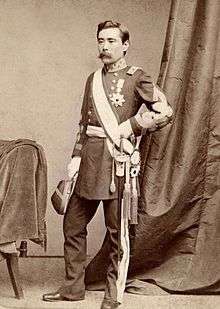 |
1st Itō | 22 December 1885 | 30 April 1888 |
| 2 | Saigō Jūdō |  |
Kuroda | 30 April 1888 | 24 December 1889 |
| 3 | Saigō Jūdō |  |
1st Yamagata | 24 December 1889 | 17 May 1890 |
| 4 | Kabayama Sukenori |  |
1st Yamagata | 17 May 1890 | 6 May 1891 |
| 5 | Kabayama Sukenori |  |
1st Matsukata | 6 May 1891 | 8 August 1892 |
| 6 | Nire Kagenori |  |
2nd Itō | 8 August 1892 | 11 March 1893 |
| 7 | Saigō Jūdō |  |
2nd Itō | 11 March 1893 | 11 September 1896 |
| 8 | Saigō Jūdō |  |
2nd Matsukata | 11 September 1896 | 12 January 1898 |
| 9 | Saigō Jūdō |  |
3rd Itō | 12 January 1898 | 30 June 1898 |
| 10 | Saigō Jūdō |  |
1st Ōkuma | 30 June 1898 | 8 November 1898 |
| 11 | Yamamoto Gonnohyōe | 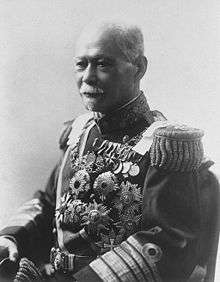 |
2nd Yamagata | 8 November 1898 | 19 October 1900 |
| 12 | Yamamoto Gonnohyōe |  |
4th Itō | 19 October 1900 | 2 June 1901 |
| 13 | Yamamoto Gonnohyōe |  |
1st Katsura | 2 June 1901 | 7 January 1906 |
| 14 | Saitō Makoto | 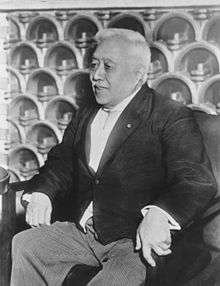 |
1st Saionji | 7 January 1906 | 14 July 1908 |
| 15 | Saitō Makoto |  |
2nd Katsura | 14 July 1908 | 30 August 1911 |
| 16 | Saitō Makoto |  |
2nd Saionji | 30 August 1911 | 21 December 1912 |
| 17 | Saitō Makoto |  |
3rd Katsura | 21 December 1912 | 20 February 1913 |
| 18 | Saitō Makoto |  |
1st Yamamoto | 20 February 1913 | 16 April 1914 |
| 19 | Yashiro Rokurō |  |
2nd Ōkuma | 16 April 1914 | 8 October 1915 |
| 20 | Katō Tomosaburō | 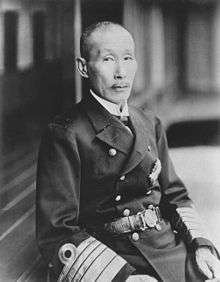 |
2nd Ōkuma | 8 October 1915 | 9 October 1916 |
| 21 | Katō Tomosaburō |  |
Terauchi | 9 October 1916 | 29 September 1918 |
| 22 | Katō Tomosaburō |  |
Hara | 29 September 1918 | 13 November 1921 |
| 23 | Katō Tomosaburō |  |
Takahashi | 13 November 1921 | 12 June 1922 |
| 24 | Katō Tomosaburō |  |
Katō | 12 June 1922 | 15 May 1923 |
| 25 | Takarabe Takeshi |  |
Katō | 15 May 1923 | 2 September 1923 |
| 26 | Takarabe Takeshi |  |
2nd Yamamoto | 2 September 1923 | 7 January 1924 |
| 27 | Murakami Kakuichi |  |
Kiyoura | 7 January 1924 | 11 June 1924 |
| 28 | Takarabe Takeshi |  |
Katō | 11 June 1924 | 30 January 1926 |
| 29 | Takarabe Takeshi |  |
1st Wakatsuki | 30 January 1926 | 20 April 1927 |
| 30 | Keisuke Okada | 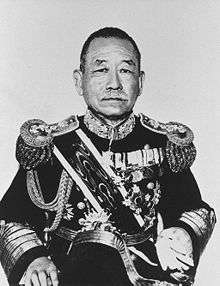 |
1st Tanaka | 20 April 1927 | 2 July 1929 |
| 31 | Takarabe Takeshi |  |
Hamaguchi | 2 July 1929 | 3 October 1930 |
| 32 | Kiyokazu Abo |  |
Hamaguchi | 3 October 1930 | 14 April 1931 |
| 33 | Kiyokazu Abo |  |
2nd Wakatsuki | 14 April 1931 | 13 December 1931 |
| 34 | Mineo Ōsumi |  |
Inukai | 13 December 1931 | 26 May 1932 |
| 35 | Keisuke Okada |  |
Saitō | 26 May 1932 | 9 January 1933 |
| 36 | Mineo Ōsumi |  |
Saitō | 9 January 1933 | 8 July 1934 |
| 37 | Mineo Ōsumi |  |
Okada | 8 July 1934 | 9 March 1936 |
| 38 | Osami Nagano |  |
Hirota | 9 March 1936 | 2 February 1937 |
| 39 | Mitsumasa Yonai |  |
Hayashi | 2 February 1937 | 4 June 1937 |
| 40 | Mitsumasa Yonai |  |
1st Konoe | 4 June 1937 | 5 January 1939 |
| 41 | Mitsumasa Yonai |  |
1st Hiranuma | 5 January 1939 | 30 August 1939 |
| 42 | Zengo Yoshida |  |
Abe | 30 August 1939 | 16 January 1940 |
| 43 | Zengo Yoshida |  |
Yonai | 16 January 1940 | 22 July 1940 |
| 44 | Zengo Yoshida |  |
2nd Konoe | 22 July 1940 | 5 September 1940 |
| 45 | Koshirō Oikawa | |
2nd Konoe | 5 September 1940 | 18 July 1941 |
| 46 | Koshirō Oikawa | |
3rd Konoe | 18 July 1941 | 18 October 1941 |
| 47 | Shigetarō Shimada | |
Tojo | 18 October 1941 | 17 July 1944 |
| 48 | Naokuni Nomura |  |
Tojo | 17 July 1944 | 22 July 1944 |
| 49 | Mitsumasa Yonai |  |
Koiso | 22 July 1944 | 7 April 1945 |
| 50 | Mitsumasa Yonai |  |
Suzuki | 7 April 1945 | 17 August 1945 |
| 51 | Mitsumasa Yonai |  |
Higashikuni | 17 August 1945 | 9 October 1945 |
| 52 | Mitsumasa Yonai |  |
Shidehara | 9 October 1945 | 1 December 1945 |
References
Books
- Asada, Sadao (2006). From Mahan to Pearl Harbor: The Imperial Japanese Navy and the United States. US Naval Institute Press. ISBN 1-55750-042-8.
- Schencking, J. Charles (2005). Making Waves: Politics, Propaganda, And The Emergence Of The Imperial Japanese Navy, 1868–1922. Stanford University Press. ISBN 0-8047-4977-9.
- Spector, Ronald (1985). Eagle Against the Sun. New York: Vintage Books. ISBN 0-394-74101-3.
External links
- "Foreign Office Files for Japan and the Far East". Adam Matthew Publications.
Notes
- ↑ Spector
